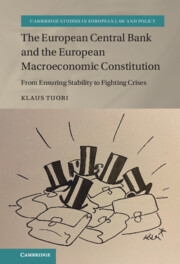 The European Central Bank and the European Macroeconomic Constitution
The European Central Bank and the European Macroeconomic Constitution from Part I - The ECB as the Central Bank of the European Macroeconomic Constitution
Published online by Cambridge University Press: 15 September 2022
The chapter describes and analyses the principles of European Macroeconomic Constitution and how it guides the ECB and EU in its macroeconomic governance. The principles can be divided into objectives and safeguards. The main objective of the economic constitution, integration through internal market, continues but gets price stability as the main macroeconomic objective, and to an extent a more elaborated open market economy principle to guide EU institutions. The safeguards start from central bank independence that are further defined by the prohibition of central bank financing and a narrow central banking model without explicit value judgments. Member States remain responsible for the other areas of economic policy with the obligation of sound fiscal policy. The principles form a logical whole and complement the earlier microeconomic constitution. However, the assumptions and theory backgrounds of the two constitutions differ substantially, which has many implications, including for the role of law and courts as well as independent experts, such as the ECB. These implications have even become apparent already in the earlier case law by the CJEU.
To save this book to your Kindle, first ensure [email protected] is added to your Approved Personal Document E-mail List under your Personal Document Settings on the Manage Your Content and Devices page of your Amazon account. Then enter the ‘name’ part of your Kindle email address below. Find out more about saving to your Kindle.
Note you can select to save to either the @free.kindle.com or @kindle.com variations. ‘@free.kindle.com’ emails are free but can only be saved to your device when it is connected to wi-fi. ‘@kindle.com’ emails can be delivered even when you are not connected to wi-fi, but note that service fees apply.
Find out more about the Kindle Personal Document Service.
To save content items to your account, please confirm that you agree to abide by our usage policies. If this is the first time you use this feature, you will be asked to authorise Cambridge Core to connect with your account. Find out more about saving content to Dropbox.
To save content items to your account, please confirm that you agree to abide by our usage policies. If this is the first time you use this feature, you will be asked to authorise Cambridge Core to connect with your account. Find out more about saving content to Google Drive.